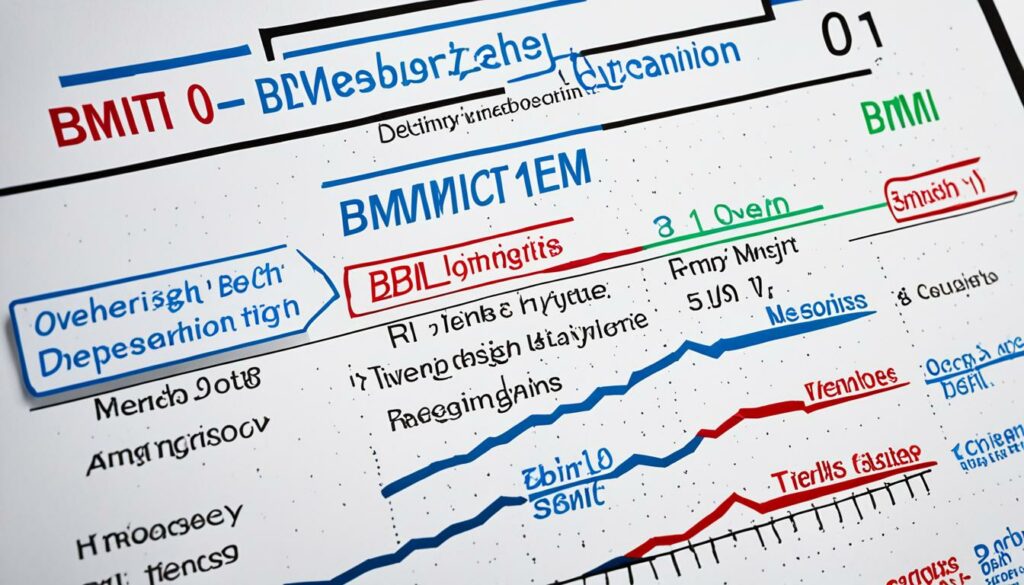Overweight BMI Standard for Teens Explained
Body mass index (BMI) is a widely used measurement to assess weight status in individuals. For teens, the BMI standard for determining overweight is based on age and sex, taking into account their growth and development. Understanding the BMI criteria for overweight teens is essential in promoting their overall health and well-being.
The CDC Growth Charts provide healthcare providers with BMI-for-age percentile curves to monitor the growth of teens aged 2-19 years. These percentile curves categorize BMI based on sex and age, which differ from those used for adults. It’s important to note that teens may have different BMI cutoffs for overweight and obesity compared to adults.
Key Takeaways:
- The BMI standard for determining overweight in teens is based on age- and sex-specific BMI percentiles.
- Teens may have different BMI cutoffs for overweight and obesity compared to adults.
- The CDC Growth Charts provide healthcare providers with the necessary tools to monitor the growth of teens and assess their weight status accurately.
- Understanding the BMI criteria for overweight teens can help healthcare providers identify potential health risks early on.
- Promoting a healthy lifestyle and addressing weight concerns in teens can lead to improved overall health outcomes.
How is BMI Calculated for Teens?

Calculating the BMI for teens follows the same formula as for adults. The weight is measured in kilograms (kg), and the height is measured in meters (m). To calculate the BMI, divide the weight in kilograms by the square of the height in meters.
“BMI = weight (kg) / (height (m))^2”
However, since most people measure height in centimeters (cm), it’s important to convert centimeters to meters by dividing by 100. For example, if a teenager’s height is 160 cm, divide 160 by 100 to convert it to 1.6 meters.
When calculating BMI for teenagers, it’s crucial to use age- and sex-specific reference charts to interpret the results accurately. These charts take into account the growth patterns of adolescents and provide a more accurate assessment of their weight status.
Example:
Let’s take an example of a 16-year-old girl who weighs 60 kg and has a height of 1.65 meters. To calculate her BMI, divide her weight (60 kg) by the square of her height (1.65 * 1.65). This gives us a BMI of approximately 22.04.
Using the age- and sex-specific reference charts, healthcare providers can then determine the BMI percentile for this teenager. The percentile indicates how the teen’s BMI compares to their peers of the same age and sex.
BMI Calculation Table:
| Weight Category | BMI Range |
|---|---|
| Underweight | Below 5th percentile |
| Healthy Weight | 5th – 85th percentile |
| Overweight | 85th – 95th percentile |
| Obese | Above 95th percentile |
Interpreting a teenager’s BMI measurement involves comparing their BMI percentile to these categories to determine if they are underweight, have a healthy weight, are overweight, or obese.
BMI Categories for Teens
BMI categories for teens are based on sex- and age-specific BMI percentiles. These categories help healthcare providers assess the weight status of teens and identify potential health risks.
Underweight
A teen with a BMI below the 5th percentile is considered underweight. It’s important to address issues related to underweight as it may indicate inadequate nutrition or underlying health conditions that require attention.
Healthy Weight
A BMI between the 5th and 85th percentile is considered a healthy weight for teens. Teens falling within this range generally have a BMI that is considered within the normal range for their age and sex.
Overweight
Teens with a BMI between the 85th and 95th percentile are considered overweight. This indicates that they have a higher BMI than 85% of their peers. Being overweight in the teenage years can increase the risk of developing health problems later in life, such as heart disease and type 2 diabetes.
Obese
A BMI above the 95th percentile is considered obese for teens. This means that they have a higher BMI than 95% of their peers. Obesity in teenagers is associated with various health risks, including high blood pressure, high cholesterol, and increased risk of chronic diseases.
Healthcare providers use these BMI categories to assess the weight status of teens and determine appropriate interventions if necessary. It is important to monitor the BMI of teenagers regularly and provide guidance for maintaining a healthy weight through proper nutrition, physical activity, and lifestyle choices.
Determining Overweight in Teens

When it comes to determining overweight in teens, healthcare providers rely on age- and sex-specific BMI percentile charts. These charts provide a valuable tool for assessing weight status accurately and identifying indicators of teenage overweight. By comparing a teen’s BMI to these percentile charts, healthcare providers can determine if the teen falls within the overweight range.
A teen is considered overweight if their BMI falls between the 85th and 95th percentile for their age and sex. This means that they have a higher BMI than 85% of their peers but are not classified as obese. By using these BMI percentiles, healthcare providers can identify signs of excess weight in adolescents and intervene appropriately if necessary.
Determining overweight in teens is critical because excess weight during adolescence can have long-term health implications. By identifying obesity in teenagers early on, healthcare providers can implement interventions and support that promote healthy habits and prevent further health complications.
One important tool in this process is the use of age- and sex-specific BMI percentile charts, which allow healthcare providers to identify overweight in teens accurately and tailor interventions to their specific needs. By combining the use of BMI percentiles with other health indicators, healthcare professionals can provide comprehensive care and support to help teens achieve and maintain a healthy weight.
Key Points:
- Determining overweight in teens involves comparing their BMI to age- and sex-specific BMI percentile charts.
- A teen is considered overweight if their BMI falls between the 85th and 95th percentile for their age and sex.
- By using BMI percentile charts, healthcare providers can identify signs of excess weight in adolescents and intervene appropriately.
- Identifying obesity in teenagers early on allows for timely interventions and support to prevent further health complications.
- Combining the use of BMI percentiles with other health indicators enables healthcare professionals to provide comprehensive care and support.
Understanding Obesity in Teens

Obesity in teens refers to having excess body fat, and it is a serious long-term disease. Teenage obesity can be caused by a combination of factors, including genetics, socioeconomic issues, metabolism, lifestyle choices, and certain endocrine disorders, diseases, or medications. Addressing and managing obesity in teens is crucial to prevent potential health complications and improve overall well-being.
Health Risks of Teen Obesity
Obesity in teenagers is associated with various health risks, including:
- High blood pressure
- High cholesterol levels
- Type 2 diabetes
- Joint problems
- Breathing problems
- Psychosocial effects such as low self-esteem and social stigma
These health risks can have long-term consequences and significantly impact the overall health of teenagers. Obesity in teens should not be ignored, as it can lead to chronic diseases and reduce their quality of life.
Preventing Complications and Improving Health Outcomes
Addressing and managing obesity in teens is essential to prevent potential complications and improve their overall health outcomes. It involves a comprehensive approach, which includes:
- Encouraging healthy eating habits and promoting a balanced diet with nutritious foods.
- Promoting regular physical activity and reducing sedentary behaviors.
- Providing education and support for behavior changes.
- Considering any underlying medical conditions and addressing them appropriately.
- Involving a multidisciplinary healthcare team, including dieticians, psychologists, and physicians.
By addressing teen obesity and implementing these strategies, we can help teenagers lead healthier lives and reduce the risk of long-term health complications.
| Health Risks of Teen Obesity | Preventive Measures |
|---|---|
| High blood pressure | Educate about the importance of a healthy lifestyle and encourage regular exercise. |
| High cholesterol levels | Provide guidance on a balanced diet with limited saturated and trans fats. |
| Type 2 diabetes | Promote weight loss through a combination of diet and exercise. |
| Joint problems | Encourage low-impact activities and exercises to reduce stress on joints. |
| Breathing problems | Advise on weight loss to alleviate pressure on the respiratory system. |
| Psychosocial effects | Provide counseling and support to address self-esteem and social issues. |
Risks Factors for Obesity in Teens

Teen obesity can be influenced by several risk factors, which can contribute to the development of overweight and obesity in adolescents. It is important to understand these factors to develop effective prevention strategies and interventions.
Genetic Predisposition
Genetics plays a role in determining a teen’s susceptibility to obesity. Having obese parents or close relatives with weight issues can increase the risk of teen obesity.
Metabolism
A slower metabolism can make it easier for weight to be gained and more difficult for weight to be lost. Individual differences in metabolism can impact a teen’s risk of becoming overweight.
Socioeconomic Factors
Belonging to a low-income family can be associated with limited access to nutritious foods, limited opportunities for physical activity, and higher exposure to unhealthy food environments, all of which can contribute to teenage obesity.
Lifestyle Choices
Sedentary behaviors, such as spending excessive time watching TV or playing video games, can increase the risk of teen obesity. Lack of physical activity combined with unhealthy dietary habits can contribute to weight gain.
Dietary Factors
A diet high in sugary and fatty foods can contribute to excessive calorie intake and weight gain in adolescents. Consuming sugary beverages, fast food, and processed snacks can increase the risk of obesity.
Sleep Deprivation
Inadequate sleep has been associated with an increased risk of obesity in teens. Lack of sleep can disrupt hormones that regulate appetite, leading to increased food cravings and overeating.
Risk factors for teen obesity can be influenced by various factors, including genetics, metabolism, socioeconomic status, lifestyle choices, and sleep patterns. Identifying these risk factors is crucial in developing targeted interventions and preventive measures to curb the prevalence of teenage obesity.
Diagnosing Obesity in Teens
Diagnosing obesity in teens involves assessing their weight and body fat using various methods. One of the most commonly used methods is the calculation of Body Mass Index (BMI). Healthcare providers measure the teen’s weight and height and use age- and sex-specific BMI-for-age percentile charts to interpret the results.
By comparing the teen’s BMI to the percentile charts, healthcare providers can determine if the teen is overweight or obese. If a teen’s BMI falls between the 85th and 95th percentile, they are considered overweight, indicating a higher BMI than 85% of their peers. If the teen’s BMI is above the 95th percentile, they are considered obese.
In addition to BMI, healthcare providers also consider other factors when diagnosing obesity in teens. These factors may include family history of obesity, blood pressure levels, cholesterol levels, and concerns about weight and overall health. By considering these factors alongside BMI, healthcare providers can make an accurate diagnosis and develop appropriate treatment plans for teens with obesity.
An accurate diagnosis of obesity in teens is crucial for effective intervention and management. It allows healthcare providers to address potential health risks, develop personalized treatment strategies, and provide necessary support for teens to achieve and maintain a healthy weight.
Methods for Identifying Obesity in Teenagers
In addition to calculating BMI, healthcare providers may use other methods to assess obesity in teenagers. Some of these methods include:
- Measurement of body fat percentage using skinfold thickness measurements or bioelectrical impedance
- Assessment of waist circumference to determine abdominal obesity
- Evaluation of physical symptoms and health conditions associated with obesity
- Tracking growth patterns and changes in weight and body composition over time
These methods provide additional insight into the teenager’s body composition and health status, helping healthcare providers make a comprehensive assessment of obesity and tailor treatment plans accordingly.
Measuring body fat percentage is one method used to identify obesity in teenagers. It provides a more detailed understanding of the distribution of fat in the body and can help determine the severity of obesity.
“Accurate diagnosis of obesity in teens is essential for effective intervention and management.”
By combining different assessment methods and considering individual factors, healthcare providers can diagnose obesity in teenagers and provide appropriate interventions to promote healthy weight management and overall well-being.
Treating Obesity in Teens

When it comes to managing obesity in teenagers, a comprehensive and multidisciplinary approach is key. Tailored interventions and strategies are essential to help teens make sustainable lifestyle modifications, improve their self-esteem, and achieve a healthier weight.
Diet counseling plays a crucial role in teen obesity treatment. By promoting healthy eating habits, healthcare professionals can assist teens in making informed choices about their nutrition. Emphasizing the importance of a balanced diet and portion control can contribute to long-term weight management.
Increasing physical activity is another vital aspect of managing obesity in teenagers. Encouraging teens to engage in regular exercise and find activities they enjoy not only helps with weight loss but also improves overall fitness and mental well-being. Exercise specialists can provide guidance and personalized exercise plans to support teens in their journey.
Behavior changes are significant in addressing teen obesity. Health professionals work with teens to identify and modify unhealthy behaviors, such as emotional eating or excessive snacking. By fostering positive attitudes towards food and self-image, teens can develop a healthier relationship with their bodies.
Individual or group therapy can be beneficial for teens struggling with obesity. Mental health professionals can address potential underlying emotional or psychological issues contributing to weight gain. By providing a supportive space for teens to discuss their feelings and experiences, therapy can help them develop coping mechanisms and build resilience.
“The treatment of obesity in teens should incorporate a multidisciplinary approach and tailored interventions.”
In the treatment of teen obesity, collaboration with nutritionists, mental health professionals, and exercise specialists is crucial. This multidisciplinary approach ensures comprehensive support and guidance throughout the weight loss journey. By addressing the physical, emotional, and psychological aspects of obesity, healthcare providers maximize the chances of successful long-term outcomes.
Here is an example of a table showcasing strategies for weight loss in teens:
| Strategies | Description |
|---|---|
| Healthy eating | Promoting a well-balanced diet with appropriate portion sizes. |
| Regular physical activity | Encouraging regular exercise and participation in enjoyable activities. |
| Behavior modifications | Identifying and modifying unhealthy behaviors and patterns. |
| Supportive therapy | Providing individual or group therapy to address emotional and psychological factors. |
The combination of these treatment strategies, tailored to each individual, helps teens achieve and maintain a healthier weight. With ongoing support and guidance, teens can build the skills and habits necessary for long-term success in managing obesity.
Complications of Obesity in Teens
Obesity in teens can have numerous complications and negative effects on their health. The long-term effects of teen obesity are significant and can impact their physical and mental well-being. It’s important to address and manage obesity in teens to prevent further health complications and improve their overall quality of life.
Health Risks of Teen Obesity
Teen obesity is associated with various health risks that can persist into adulthood. These risks include:
- High Blood Pressure: Obesity increases the risk of developing high blood pressure, which can lead to heart disease and other cardiovascular problems.
- High Cholesterol: Teen obesity can contribute to elevated cholesterol levels, increasing the risk of heart disease.
- Type 2 Diabetes: Obesity is a significant risk factor for developing type 2 diabetes in teenagers.
- Joint Problems: Excess weight puts strain on the joints, leading to conditions such as osteoarthritis and joint pain.
- Sleep Apnea and Breathing Problems: Teen obesity can cause breathing difficulties during sleep, leading to sleep apnea and other respiratory problems.
Psychosocial Effects of Teen Obesity
In addition to the physical health risks, teen obesity also has psychosocial effects that can negatively impact their self-esteem and social interactions. These effects include:
- Low Self-Esteem: Teens with obesity may experience low self-esteem and poor body image, which can affect their overall well-being.
- Social Stigma: Adolescents with obesity may face bullying, discrimination, and social isolation, leading to emotional distress.
Addressing these complications and supporting teens in managing their weight is crucial for their long-term health and well-being. By implementing effective prevention strategies and providing comprehensive support, we can help teens overcome the challenges of obesity and improve their quality of life.
Prevention of Obesity in Teens
Preventing teenage obesity is essential in promoting the overall health and well-being of adolescents. By implementing strategies that encourage healthy habits and behaviors, parents and caregivers can play a crucial role in obesity prevention. Here are some tips and recommendations:
1. Promote Healthy Eating
- Encourage the consumption of fruits, vegetables, whole grains, and lean proteins.
- Limit the intake of sugary drinks, fast food, and processed snacks.
- Involve teens in meal planning and preparation to develop their awareness of nutritious food choices.
2. Encourage Regular Physical Activity
- Engage teens in at least 60 minutes of moderate to vigorous physical activity every day.
- Encourage participation in sports, dancing, biking, or other activities they enjoy.
- Limit sedentary behaviors such as excessive screen time and encourage outdoor play or hobbies that involve movement.
3. Be a Role Model
Set an example by leading a healthy lifestyle yourself. Show your teen the importance of balanced eating, regular exercise, and self-care.
4. Provide Access to Nutritious Foods
Ensure that nutritious snacks and meals are readily available at home. Stock up on fruits, vegetables, and healthy snacks instead of sugary and high-calorie options.
5. Ensure Adequate Sleep
Encourage a consistent sleep schedule for teenagers to promote proper rest and rejuvenation. Aim for 8-10 hours of sleep each night.
Promoting healthy habits and behaviors is key to preventing obesity in teenagers. By creating a supportive environment that encourages nutritious eating, regular physical activity, and adequate sleep, parents and caregivers can help teens maintain a healthy weight and reduce the risk of obesity-related health complications.
Remember, the focus should be on overall health and well-being rather than solely on weight. By instilling positive habits from an early age, we can empower teens to make lifelong choices that support their physical and mental well-being.
Conclusion
Overweight and obesity in teens can have significant health implications, including an increased risk of chronic diseases and psychosocial effects. It is essential to accurately assess and diagnose teens’ weight status to provide appropriate interventions.
The BMI standard for determining overweight in teens is based on age- and sex-specific BMI percentiles. These guidelines help healthcare providers classify teens’ BMI and identify potential health risks.
Preventive measures, early intervention, and a holistic approach involving lifestyle modifications are crucial in managing and preventing teen obesity. By promoting healthy habits and behaviors, we can improve teens’ overall health and well-being, ultimately reducing the burden of chronic diseases.
Overall, addressing teen obesity is vital for their quality of life and long-term health. By implementing evidence-based strategies and supporting teens in their journey towards a healthier weight, we can make a positive impact on their future.
FAQ
What is the BMI standard for determining overweight in teens?
The BMI standard for determining overweight in teens varies depending on their age and sex. Healthcare providers use age- and sex-specific BMI percentiles to assess the weight status of teens accurately.
How is BMI calculated for teens?
BMI is calculated for teens using the same formula as for adults. The weight is measured in kilograms (kg) and the height is measured in meters (m). The weight in kilograms is divided by the square of the height in meters to calculate the BMI.
What are the BMI categories for teens?
The BMI categories for teens include underweight, healthy weight, overweight, and obese. The specific ranges for each category may vary depending on the age and sex of the teen.
How do you determine overweight in teens?
Overweight in teens is determined by comparing their BMI to age- and sex-specific BMI percentile charts. If a teen’s BMI falls between the 85th and 95th percentile, they are considered overweight.
What is obesity in teens?
Obesity in teens refers to having excess body fat. It is a serious long-term disease that can be caused by various factors such as genetics, lifestyle choices, and certain medical conditions.
What are the risk factors for obesity in teens?
The risk factors for obesity in teens include genetic predisposition, metabolism, socioeconomic factors, lifestyle choices, and certain medical conditions. These factors can increase the likelihood of developing obesity during adolescence.
How is obesity diagnosed in teens?
Obesity in teens is diagnosed by calculating their BMI and comparing it to age- and sex-specific BMI-for-age percentile charts. If a teen’s BMI falls above the 95th percentile, they are considered obese.
What are the treatment options for obesity in teens?
The treatment of obesity in teens involves a multidisciplinary approach and tailored interventions. It may include dietary counseling, promoting healthy eating habits, increasing physical activity, behavior changes, and individual or group therapy.
What are the complications of obesity in teens?
Obesity in teens can lead to numerous complications, including high blood pressure, high cholesterol, type 2 diabetes, joint problems, sleep apnea, breathing problems, and psychosocial effects such as low self-esteem and social stigma.
How can obesity in teens be prevented?
Preventing obesity in teens involves creating a supportive environment that promotes healthy habits and behaviors. Parents and caregivers can play a crucial role by encouraging healthy eating, regular physical activity, and limiting screen time.
What are the key takeaways on teenage obesity?
Understanding teenage obesity requires considering age- and sex-specific BMI percentiles, diagnosing obesity based on BMI calculations, and implementing a multidisciplinary approach to treatment and prevention. It is crucial to address obesity in teens to prevent further complications and improve overall health and well-being.







